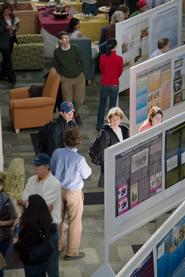
After spending their summer doing collaborative research with faculty, more than 100 Hamilton students got to show off the fruits of their labors during Family Weekend, Oct. 30-Nov. 2. Poster sessions for Emerson Summer Collaboration Grants, Levitt Summer Research Fellows and summer science research took place on Oct. 31 in KJ Commons and in the Science Center Wellin Atrium.
Parents, faculty and students were enthusiastic about the sessions and impressed with the depth and breadth of the work. Associate Professor of Economics Jeff Pliskin, who is director of the Arthur Levitt Public Affairs Center, said that the poster sessions are a great way to "share with the community the high quality research our students did over the summer."
Associate Director for Community Research Judy Owens-Manley, who worked with Dan Rudel '10 on his Levitt project titled "Theories for Community Integration: Refugees in Utica., N.Y., said summer research and the subsequent poster sessions "give students a real opportunity to delve into something in depth in a way they can't during the school year. Hamilton promotes this one-on-one connection with a faculty member," she noted.
Andrew Miller '10 worked with Professor of Economics Chris Georges on a Levitt project titled "Agent Based Modeling of Firm Dynamics and Labor Turnover." The summer research grant was "really an opportunity to explore things I've gained an interest in, in-depth," Miller explained. "I'm grateful Professor Georges encouraged me to do it and that Hamilton provides opportunities to do things like this over the summer."
Nancy McMillan, whose nephew Kevin O'Connor '09 presented a poster titled "Renewing Anacostia and Shaw: Interactions between Class, race and Conceptions of Place in the Nation's Capital," enjoyed the session in KJ Commons. "I'm impressed that these students who are not seniors but underclassmen have done this level of work in their early years of college," she said.
Cindy Zhu '10 provided just such an example. She conducted her research after her sophomore year with Associate Professor of Economics Stephen Wu on a topic related to an internship she had before she came to Hamilton. She said she learned a lot in doing her research this summer, on the topic "The Impact of China's Housing Reform: Evidence from Shanghai."
While most students presented posters, recipients of Emerson Summer Collaboration Grants had the option of giving an oral presentation of their summer research. Katrina Huffaker, whose son Greg '09 discussed his Emerson project titled "Utica and the Mohawk Valley: A History in Pictures," commented, "We were very impressed by the variety of subjects that the students chose for their Emerson poster projects. The students we spoke with were well informed and excited to explain their projects to us."
Emerson Grant projects covered a wide array of topics and disciplines, including "Slight of Tongue: Code-switching Phenomenon (Eileen Rivera '10/Professor Masaaki Kamiya), "Misinterpreting the Middle East: Western Bias in Approaches in Middle Eastern History" (Kelsey Rice '10/Professor Shoshana Keller), and "Why We Need Supermen: The Purpose of Superheroes in Society" (Brendan Conway '09/Professor Tina Hall).
Over in the Science Center, a large crowd looked at posters on such topics as "Grain Size Distribution in the Eastern Basin of Oneida Lake" (Megan Fung '10/ Professor Eugene Domack), "ADHS Symptomatology and College Adjustment" (Sam Colalillo '10, Anthony Sali '10/ Professor Tara McKee) and "Quenching Resistance of Chelated Fluorescent Trivalent Ianthanide (Matthew Breen '11/ Professor Karen Brewer).
Professor of Biology David Gapp said posters -- and student/faculty research -- have come a long way since he started working with students in 1985. The first formal program in summer research began in 1991, with around eight students, and "we didn't have poster sessions until years later," Gapp said. Over the years the numbers have grown and this past summer, 82 students worked with a Hamilton science faculty member.
Bill Pfitsch, associate professor of biology, said summer collaborative research "gives students a complete experience of the scientific venture. They learn it can be frustrating, fun and that an experiment does not always work out."
Gapp added that the intense one-on-one summer research "gives students a chance to see that science is more than a three-hour-a-week experience."
Gapp and Pfitsch noted that collaboration also occurs between disciplines during the summer "because there's time to build the connections and support each other." They cited examples of biologists working with chemists and chemists working with physicists, as well as inter-departmental collaborations.
Parents of science students were impressed with what they saw and learned. Sue Ruddiman, mother of Jessica '09 commented that the posters provided a "good chance to show what they spent their summer doing." Joe Maglaty, father of Marisa '09 observed "the level of research look like graduate school work."
For more information about 2008 Summer Research projects at Hamilton, please visit the Summer Research site. Information about 2009 summer research opportunities will be available at the beginning of the spring 2009 semester.
Posted November 7, 2008
